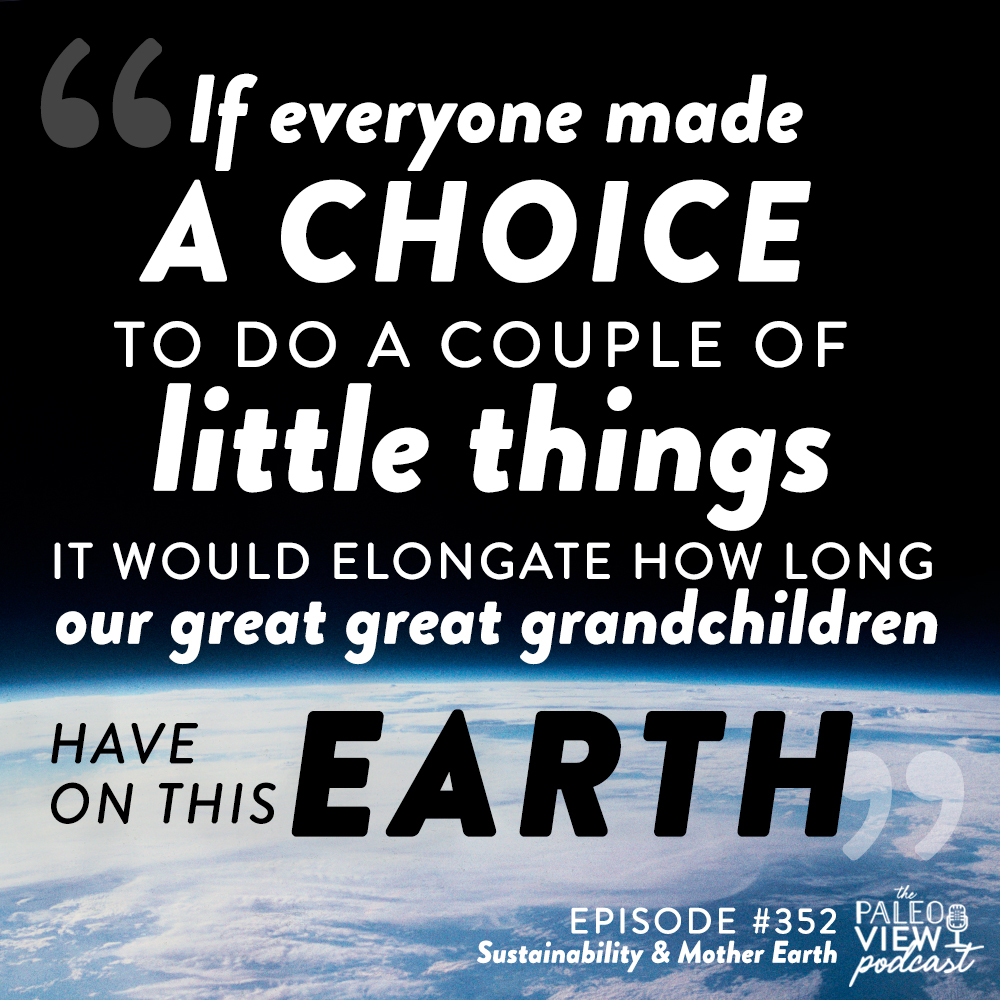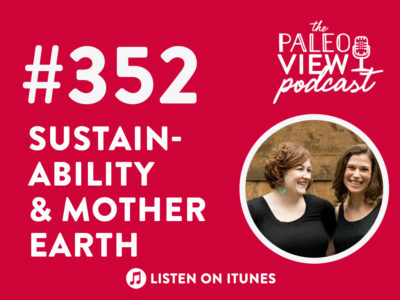On this episode, Sarah and Stacy discuss net-zero carbon emissions and the steps that we can each personally take to reduce our carbon footprint. From the little habit changes to the products we purchase and the environmental protectionism missions we support; tune in to this week’s episode to learn how you can take on sustainability practices that will protect mother Earth for many generations to come.
If you enjoy the show, please review it on iTunes!
The Paleo View (TPV), Episode 352: Sustainability & Mother Earth
-
-
(0:41) Welcome
- Welcome back to The Paleo View listeners! And boy do we have a show for you today!
- This week Sarah and Stacy will be talking about sustainability
- While this is a topic that Sarah and Stacy talk about often as it pertains to diet and lifestyle, today’s episode will focus on two specific pieces to the puzzle
- Why is sustainability so important
- What can we all do in general
- This episode was inspired by Earth Day and the new show Our Planet
- Stacy’s son Finn came home from school recently with a lot of information on what resources will soon be gone, and Stacy is excited to see that this is a conversation even happening at that level
- While this is a topic that Sarah and Stacy talk about often as it pertains to diet and lifestyle, today’s episode will focus on two specific pieces to the puzzle
- So for this week’s episode, we are going to get you listeners fired up so that you can walk away with some action items and feel inspired to talk to others about this as well
- There is no motive behind this episode, other than we want this planet to be here for our children
- We are going to mention a lot of different things you can do or places you can support and its because Stacy and Sarah are so very passionate about protecting the planet
- One of the things that Sarah did at her workshop in February was to end the entire event with a discussion on how our dietary priorities can translate into looking after the planet
- For this week’s episode, Sarah looks forward to taking that conversation one step further and talking about our impact as human beings on the planet
- There are a lot of small adjustments that we can make that can have a really big impact
- Stacy wrote a blog post on Earth Day sharing ways in which you can not avoid damaging the environment, and ways in which you can reverse the damage as well
- What can you do to give back to the Earth? What can you do to help offset your carbon footprint?
- Sarah wants to note that Stacy and Sarah will be referring to net-zero carbon emissions, which means that ways in which we offset the carbon that we are putting out into the atmosphere
- This carbon is put into the atmosphere through the consumption of fossil fuels in various forms
- The by-product of consuming fossil fuels is the release of carbon dioxide into the air which is a greenhouse gas, which is increasing the average global temperature
- This has a lot of impact on things like the ice sheets, sea levels, major weather events
- This is creating a system where there is more energy in the atmosphere
- Heat is energy – so if you have more heat because of the rise in the average global temperature, you have more energy to put into something like a storm
- This is why we are seeing more extreme weather events
- Many catastrophic events can be traced back to manmade global climate change
- When preparing for this show, Sarah debated getting into some climate science
- However, she decided that it is so unequivocal – there is a consensus among climatologists that the increase in the average global temperature is driven by the greenhouse gases that humans are putting into the atmosphere
- It is a direct link
- There are multiple lines of evidence point to an explanation
- So we are just going to jump right into things we can do to achieve net zero carbon emissions
- That we both reduce our carbon footprint and also look at ways that we can remove carbon from the atmosphere
- We are going to hone in on real-world solutions and skip over the controversy thing because it is not a controversy
-
(11:12) Reducing the Carbon Foot Print
- Sarah remembers that when she was in school they had the three R’s – reduce, reuse and recycle and there are a ton of different strategies that fall under this banner that still apply today
- A real obvious place to start is being careful about what you throw in the trash and recycling anything that is recyclable
- Put a sheet on the fridge with information on what can go in your local recycle bin versus what needs to go in the trash bin
- If you have access to compost services or a yard where you can have a compost bin or a compost pile, these are simple steps that can help reduce how much waste you are producing that is going into landfills
- Know your recycling center policies – do you have to separate the items, or can they all go into one big bin?
- With a bit of research, you can also find local recycling centers where you can bring items that aren’t picked up (ex: batteries, old electronics)
- When you can’t hand items down (like old toys or clothes), you can drop these items off at a donation center or to a charity
- Be intentional and aware of what you consume that doesn’t need to go into landfill or into an incinerator
- There is a lot of plastic waste in America that there isn’t room for, which is then loaded on a barge and shipped overseas where other countries will take it and this is how plastic most often gets into the ocean
- Do what you can to limit your consumption of goods that requires fossil fuels to create
- If you set aside an area of your home, get a bucket with a lid that you put in the garage or closet, and put the items that need to go to the dump in that bucket
- Once it is full, simply load it in your car and next time you are driving by the dump just make a drop-off
- Sarah’s kids love nature shows and they did watch all of the Planet Earths, all of the Blue Planets and all of the Our Planet episodes
- These are great educational resources to help train your family on why habit changes matter
- Watching Our Planet did inspire Sarah to up her recycling approach
- If you don’t have solar power, are electric cars really helping the environment?
- Sarah discussed the various sources of power and the ways in which electricity are generated
- If you are not living in an area where coal is the main source of electricity than you are probably living in an area where an electric car will have a lower carbon footprint than a gasoline car
- Stacy encourages everyone to look up your recycling center’s standards to make sure that you aren’t adding items to your recycling bin that are going right into the dump
- Know your local resources, do the research and make the best choices for you
- Support brands that reuse plastic
- One of the brands that Stacy loves is Rothys – these are shoes made entirely of reused plastic
- Check out Certified B Corporation’s website to see which brands are making investments in their business to offset their carbon footprint
- When you support these brands, you are supporting a brand that puts back into the earth
- Some other brands that Stacy and Sarah recommend are:
- Alter Eco Chocolate
- Seventh Generation
- Method
- G Diapers
- Earthbound Farms
- Peeled Snacks
- Patagonia
- Athleta
- Lunapads
- Klean Kanteen
- Beauty Counter
- King Arthur Flour
- Tropical Traditions
- Check out this blog post for a full list of brands that Stacy recommends
- Sarah notes the flip side of this piece and encourages people to be aware of the companies that are not taking steps to support the environment, and are instead making the choice to do things at the environment’s expense
- Sarah shared details on what is happening in the Amazon rainforest and Madagascar and how these ecosystems are being impacted by business practices in those areas
- What we lose when we lose species
- As carbon dioxide goes into the atmosphere, plants take in carbon dioxide and put out oxygen
- So plants are the main way to sequester carbon dioxide at this time
- Don’t let perfection be the enemy of the good, but also don’t walk around with blinders on when selecting what brands you support through your dollars
- Give yourself permission to educate yourself on harmful practices and harmful companies, and give yourself permission to not support them and find alternatives
- This is where the local food movement is so critical
- Empower yourself to be motivated and do good, without guilt around not being perfect
- Allow your land to be planted and let part of your land be unmanicured
- There are many easy ways to locally increase the green space
- Even plants in your home or plants on your balcony can have an impact on the environment
- If everyone made a choice to do a couple of little things it would elongate how long our great great grandchildren have on this Earth and instill in them habits to take even more steps to heal the environment
- Stacy recommends checking out Crystal’s site, Wholefed Homestead for ideas on how to use your land
- With a little bit of homework and commitment, you can make a difference
- Make changes that are sustainable and that set you up for success so that you don’t give up
-
(45:45) More Changes You Can Make
- Sarah notes that a simple place to start with change is to get reusable grocery bags and keep them in the car
- Purchase a reusable water bottle
- Keep a reusable coffee cup with you
- Set your thermostat a couple of degrees higher in the summer, and a couple of degrees lower in the winter
- Evaluate your transportation
- Pick up some reusable silicone or cotton bags for your produce – or skip the produce bags all together
- Remember don’t let perfect be the enemy of good, make the best choices that you can at the time
- Matt and Stacy have also reduced the number of deliveries they are receiving
- Look for ways you can reduce packaging and frequency of deliveries
- There is a site where you can calculate your usage and how much you need to offset
- There are other things you can do to support initiatives outside of your house or your land
- If you are able to, you can donate trees, or water, or money towards sustainable sources of energy
- Check out BEF (Bonneville Environmental Foundation)
- And Climate Action Reserve – they review, certify and catalog offset programs
- It is very important to both Stacy and Sarah to instill this sustainability mindset in their children
- Here’s a list of resources we think are fantastic for sharing this with children of all ages:
- Matt and Stacy’s post on Arcadia Farm Camp and their website
- UNESCO’s list of programs devoted to teaching kids about the environment
- Children And The Environment: Why It’s Important To Teach Them Young
- Here’s a list of resources we think are fantastic for sharing this with children of all ages:
- There are also organizations doing great work sharing information on environmental protectionism that you can support:
- Sarah recommends doing your research and if an organization is consistent with how you want to support the planet, donate to a foundation if you can
- Sarah notes that a simple place to start with change is to get reusable grocery bags and keep them in the car
-
(53:56) Closing Thoughts
- Stacy thanked Sarah for tackling this topic with her
- This is something that Sarah is very passionate about and she is happy to bring this discussion to the podcast
- We need to live in harmony with the Earth, so it is a matter of figuring out how that harmony will work best with you
- Stacy hopes that today’s show gave you some ideas on how you can make a difference
- Remember that you don’t need to walk away from this show feeling guilty and like you need to do so many things
- Things happen over time
- Take time and make small steps towards big changes
- Feel good about every little thing you do
- When this podcast goes live, for just this weekend only, there is a special offer for Sarah’s Essential Autoimmune Protocol Ebook Library being made available
- It includes 32 AIP E-books including 6 of Sarah’s
- It is the ONLY place where you can get Sarah’s BRAND-NEW e-book, The Autoimmune Protocol: everything you need to jump-start your healing with the AIP today!
- The library is only $28 and 10% of all sales will be donated to charities working to expand and support the AIP community
- For more information, go here: https://www.thepaleomom.com/go/aip-library/
- This resource is available for four days only – first thing Friday morning, through midnight Monday evening
- Thank you again, listeners, for tuning in! We will be back next week!
-










